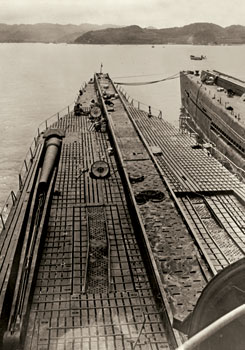
SI 2001–127
Situated half a world away from the United States, Japan’s geographic isolation influenced its war-fighting approach and led to the pursuit of unorthodox naval technologies, including a series of submarine-launched combat aircraft. The Seiran (Clear Sky Storm) was the final and most capable of these designs but was never used in combat. In the aftermath of the Doolittle Raid on Tokyo and subsequent losses during the Battle of Midway, the value of a submarine aircraft carrier with strike aircraft became more apparent. Japan already had extensive experience with submarine-launched aircraft, but in spite of a notable (if unsuccessful) 1942 bombing raid against the Oregon coast, these planes were designed for scouting, not bombing. By late 1942, the Aichi Company was developing the M6A1 as a true strike aircraft with a bomb or torpedo load of 800 kilograms. Accommodating several Seiran aircraft required construction of new submarines of unprecedented size. Work began on the I–400 class submarine with a cruising range of 20,000 miles and the capacity to accommodate three M6A1s in a special 12-foot diameter watertight hangar tube. The similar I–13 class could accommodate two Seirans.
Folding wings and stabilizers facilitated stowage. Crews could deploy and launch the submarine’s full complement of three Seirans in less than 30 minutes using a catapult built into the forward deck. The Seiran operated with floats as a reconnaissance aircraft, but the crew dispensed with them for strike missions; if not undertaking a kamikaze (special attack) mission, the aircraft would ditch near the sub on its return.
In June 1945, the I–13, I–14, I–400, and I–401 submarines were to launch their 10 aircraft in kamikaze attacks against a crucial Panama Canal lock. Before this plan was executed, the Japanese High Command decided that the U.S. naval forces assembling at Ulithi Atoll were a greater threat. The Seirans were repainted in American markings in an attempt to foil the extensive defenses of the anchorage and were nearing the launch area when the war ended.
Despite the unusual mission of the aircraft, the cockpit is consistent with other Japanese naval strike aircraft. What appears to be a gunsight atop the instrument panel is actually a bombsight. A similar looking component in the front of the navigator/gunner’s station is an aperiodic compass with reflector. The orange cones are speaking tubes. This aircraft is the sole surviving example of a Seiran.

THE SEIRAN COULD BE LAUNCHED WITHOUT FLOATS FOR KAMIKAZE MISSIONS.
SI 90–5407

THE SOLE SURVIVING SEIRAN ON DISPLAY AT THE STEVEN F. UDVAR-HAZY CENTER.
SI 2009–12432

THE IMPERIAL JAPANESE NAVY BEGAN CONSTRUCTION ON FIVE I–400 CLASS SUBMARINES, BUT WAS ONLY ABLE TO COMPLETE THREE, AND ONE OF THOSE FAILED TO MAKE IT INTO OPERATION.
SI 2004–11294

NAVIGATOR/GUNNER’S POSITION LOOKING FORWARD.
SI 2001–128

NAVIGATOR/GUNNER’S POSITION LOOKING AFT OVER THE 13MM TYPE 2 MACHINE GUN.
SI 2001–129

THE I–400’S HANGAR WAS A LARGE WATERTIGHT TUBE MOUNTED ON TOP OF THE MAIN HULL.
SI 2009–12037

A CATAPULT BUILT INTO THE DECK ALLOWED LAUNCHING OF THE SEIRAN, WITH OR WITHOUT FLOATS.
SI 2009–12035